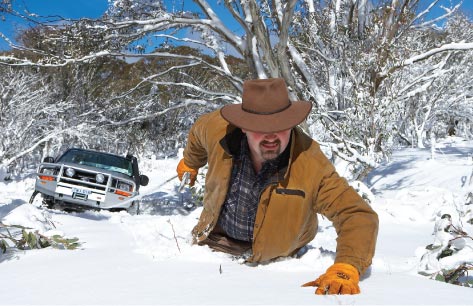Minimum Requirements for Recovery Hooks
The purpose of recovery hooks is to provide a safe and secure point from which to recover a stuck vehicle. The recovery hook should be “RATED”, strong enough to enable the recovery of a stuck vehicle, but more importantly must be designed so that if recovery forces exceed the design forces, it fails in a safe manner.
The forces that can be exerted during recovery have little to do with the size of the vehicle being recovered, and more to do with the nature of how and “HOW DEEP” the vehicle is stuck, and the “enthusiasm” of the recovery vehicle.
Example 1, a Suzuki wedged into a submerged log, is effectively an immovable object and a snatch recovery will not free it, regardless of the force applied. In this case, unless good sense is used and a different recovery technique employed, something will fail.
A vehicle stuck to stage 3 (the chassis or deeper) will take three times the Total Pull Required (force/effort) to move this vehicle. AT STAGE THREE, participants that attend Australian 4WD courses are instructed that a snatch strap should not be used, unless they shovel, tunnel and unload, to reduce the resistance and the forces placed on the weakest point of the recovery.
The potential failure points are:
1. The recovery straps (under a rate at 4ton). NOTE: when a strap is folded, wrapped around a object the rating is halved.
2. A recognized rated recovery hook, usually rated at 4 or 4.5ton
3. The recovery hook bolts
4. The vehicle chassis
The recovery strap is the only “soft” part of the recovery, so this is the most desirable component to fail. It should be noted however, that experience has shown a failed snatch strap has sufficient energy to smash a window or dent a panel.
Typically, snatch recovery straps have a minimum-breaking load of 8000kg. This is an enormous force and nearly twice the rated load of a typical 4wd recognized and rated recovery hook.
Not all 4wd recovery equipment have to comply with any specific Australian Standard, and as such manufacturers devise their own.
Australian 4WD uses and works close with Black Rat Recovery Equipment. Black Rat continue to conducted safety test on all their recovery equipment.
To ensure a safe situation always exist, Australian 4WD trains that:
1. Front and rear rated recovery hooks must be securely bolted to the chassis of the vehicle.
2. All hooks must be of forged construction and rated to 10,000lb (4ton or 4.5 ton). This value has been chosen because it is the industry standard for aftermarket recovery hooks, and the most readily available type of hook. These hooks are stamped “10,000lb”
It is very difficult to determine the material or manufacture method for a recovery hook. The most convenient way to ensure that a hook complies with this specification is to specify commercially available hooks stamped as rated to 4ton or 4.5 ton (10,000lbs). By doing this, the onus is on the manufacturer, rather than the vehicle and owner, to guarantee the load limit and failure mode.
Australian 4WD recommend that rated recovery hooks should be rated and bolted to the chassis- not welded.
We advise that Australian 4WD are not qualified to assess weld for the strength of the weld, any air bubbles within the weld and the strength of the metal material that the recovery hook is welded to.
